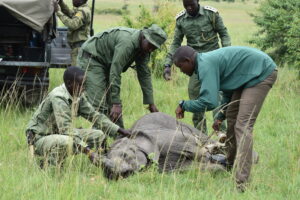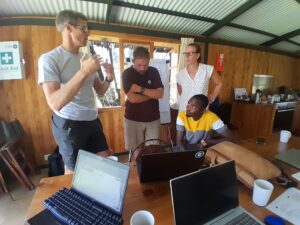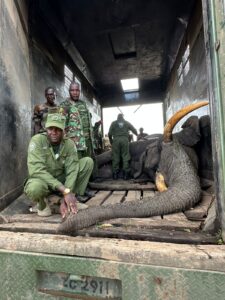 Mara Elephant Project is proud to present the first ever research and tracking report in the first quarter newsletter. This new section reflects the addition of Dr. Jake Wall as the MEP director of research and conservation on a full-time basis in January 2019. The research team, which also includes Tracking Manager Wilson Sairowua, will update supporters on the activities of the collared elephants, the environment and their team. Dr. Wall spent the first part of 2019 refining MEP’s research objectives by scoping the extent of past, current and future elephant research and conservation activities in the Mara and identified those areas where MEP can best focus its efforts.
Mara Elephant Project is proud to present the first ever research and tracking report in the first quarter newsletter. This new section reflects the addition of Dr. Jake Wall as the MEP director of research and conservation on a full-time basis in January 2019. The research team, which also includes Tracking Manager Wilson Sairowua, will update supporters on the activities of the collared elephants, the environment and their team. Dr. Wall spent the first part of 2019 refining MEP’s research objectives by scoping the extent of past, current and future elephant research and conservation activities in the Mara and identified those areas where MEP can best focus its efforts.
A research highlight for the first quarter took place in January when MEP’s Individual Collared Elephant Report 2011-2018 was finalized which documents in detail the movement patterns of the 48 elephants that MEP has tracked since 2011 up until the end of 2018. The 98-page report contains a biography, photo ID, wet and dry season home range maps and statistics plus a movement map and statistics for each elephant. It also provides an estimation of the extent to which each elephant has been crop raiding and how they distribute their time across the landscape, both inside and outside of protected areas. The report generation is almost fully automated using the Python coding language and MEP plans to repeat it every year. Publication of the report, which contains sensitive information, was made available to the Kenya Wildlife Service (KWS) in February and to other conservation and research partners. Some of which joined Dr. Wall at MEP HQ at the end of February for a three-day course on advanced geo-data analysis using the python programming language. Two staff from Save the Elephants in Sambru (Benjamin Loloju & Nelson Mwangi) and Anka Bedetti from Elephants Alive South Africa were presented with material that was a small part of a larger course on geo-data science MEP is developing and hopes to offer more widely in future.
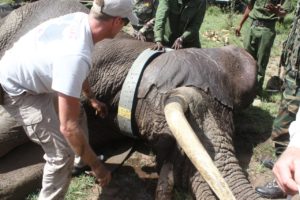 Another exciting first quarter development was that Dr. Wall was also able to collar his first official MEP elephant in March. On February 18, MEP collared elephant Lempiris’ collar stopped reporting. MEP and KWS rangers nearby his location were sent with a VHF tracker to try and locate his collar and found it had stopped working due to hardware failure. Though the collar needed to be exchanged for a newer model, we were happy to see that Lempiris was in good health. Lempiris is a large adult bull elephant that was originally collared by MEP on the 10thof November 2017 in response to an increase in human-elephant conflict along the border of Olarro Conservancy. Since Lempiris was in a high human-elephant conflict area, it was vital that we continued to gather movement data on him so rangers could respond in real-time to help save communities. Additionally, his movement data helped MEP define a northern corridor when he travelled in 2018 all the way to the Mosiro escarpment. That’s why on March 10, with the approval of KWS, MEP re-collared Lempiris in Olarro Conservancy (pictured left: Dr. Wall collaring Lempiris). KWS Vet Dr. Limo with the Sheldrick Wildlife Trust Mara Mobile Vet Unit and Olarro Conservancy rangers partnered with MEP during this operation. Lempiris was fitted with a brand-new Kevlar collar and an arrow wound was treated on his right rear leg. The operation went very well and Lempiris’ new collar is reporting with zero issues.
Another exciting first quarter development was that Dr. Wall was also able to collar his first official MEP elephant in March. On February 18, MEP collared elephant Lempiris’ collar stopped reporting. MEP and KWS rangers nearby his location were sent with a VHF tracker to try and locate his collar and found it had stopped working due to hardware failure. Though the collar needed to be exchanged for a newer model, we were happy to see that Lempiris was in good health. Lempiris is a large adult bull elephant that was originally collared by MEP on the 10thof November 2017 in response to an increase in human-elephant conflict along the border of Olarro Conservancy. Since Lempiris was in a high human-elephant conflict area, it was vital that we continued to gather movement data on him so rangers could respond in real-time to help save communities. Additionally, his movement data helped MEP define a northern corridor when he travelled in 2018 all the way to the Mosiro escarpment. That’s why on March 10, with the approval of KWS, MEP re-collared Lempiris in Olarro Conservancy (pictured left: Dr. Wall collaring Lempiris). KWS Vet Dr. Limo with the Sheldrick Wildlife Trust Mara Mobile Vet Unit and Olarro Conservancy rangers partnered with MEP during this operation. Lempiris was fitted with a brand-new Kevlar collar and an arrow wound was treated on his right rear leg. The operation went very well and Lempiris’ new collar is reporting with zero issues.
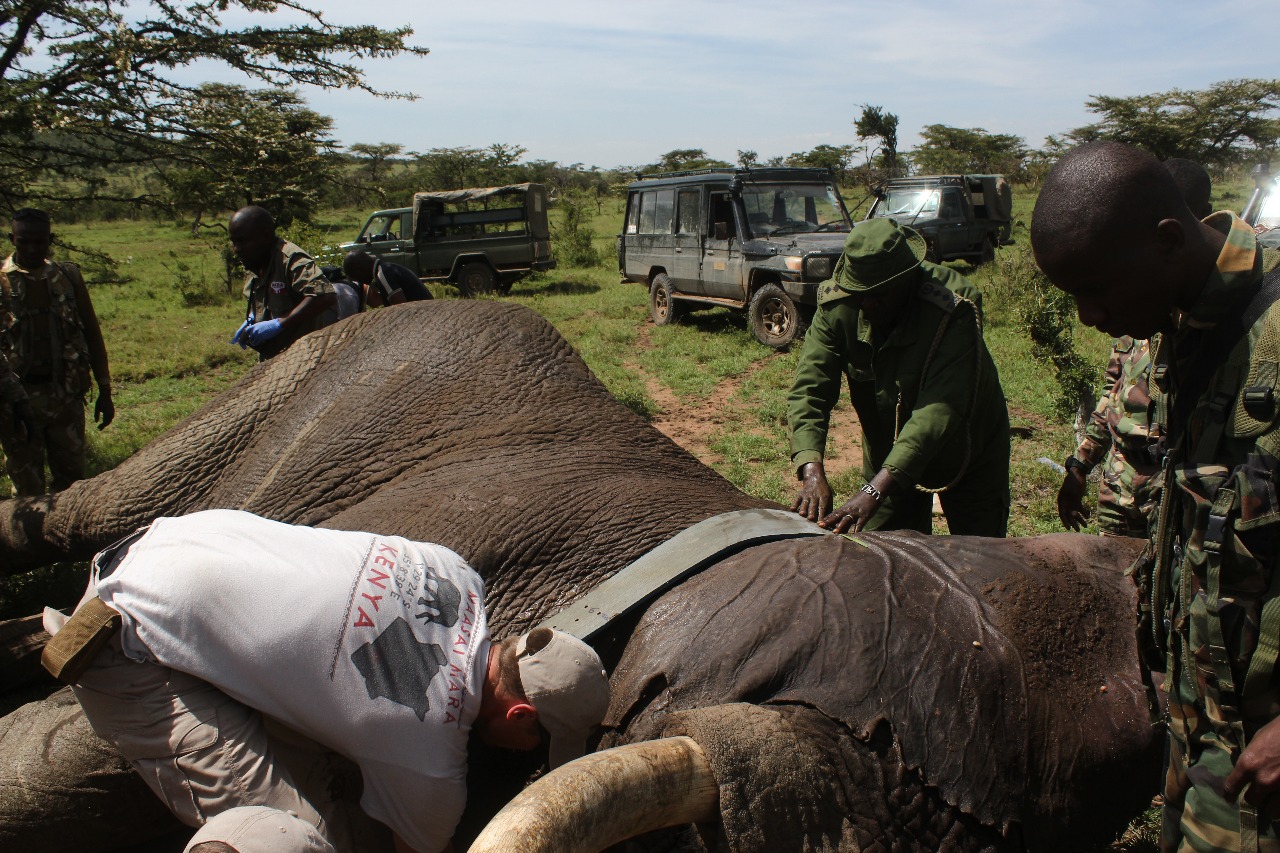
The entire team during the collaring operation for Lempiris.
The research team has been working on setting up the new MEP EarthRanger server that will be MEP’s platform for tracking elephants, aircraft, rangers and vehicles. They have also been working on entering field reports for the monitoring of illegally killed elephants (MIKE), elephant collaring and collar failure events into EarthRanger for future analysis. In February, the focus was on developing data collection workflows for the type of data important for understanding not only collared elephant movement and conflict patterns, but for measuring the landscape and environment. At the center of this is the EarthRanger software being used for data collection and storage and tailoring it to meet MEP’s expanding data and analysis needs. In relation to this, Dr. Jake Wall attended an AfriMov workshop the week of March 25 in Tanzania that was funded by a grant received by Grant Hopcraft and Tom Morrison at the University of Glasgow. The goal of the workshop was to consolidate movement data on African species into a single database and then ask general questions – i.e., compare & contrast the movements of animals across species and regions.
In February, Jake hosted Dr. Michelle Henley at the beginning of the month for three days. Michelle is the founder of Elephants Alive, based in South Africa, and she has over twenty years’ experience tracking elephants with satellite collars and has done a great deal of research on elephant foraging dynamics and we have a lot to learn from Michelle’s expertise. Michelle presented her research at MEP and gave a field demonstration of the long-term individual identification data collection procedures used by Elephants Alive. MEP is hoping to form a scientific partnership with Elephants Alive and collaborate on a number of topics.
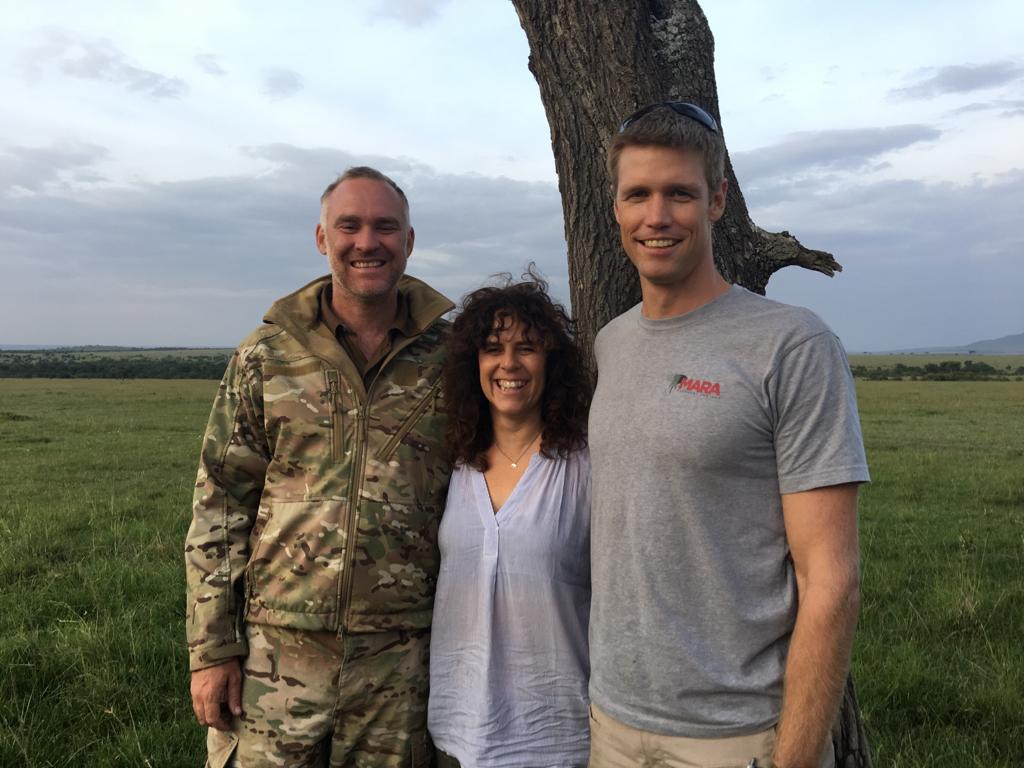
MEP CEO Marc Goss with Michelle and Jake.
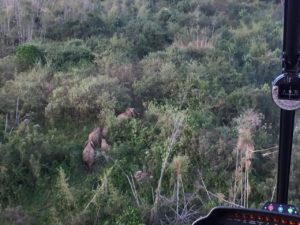 During the first quarter of 2019, MEP had 14 active collars in the Mara and another two in the Mau Forest. During this quarter, there was very little increase in range and all elephants were moving at relatively low speeds. The two collared elephants in the Mau (pictured right: Bettye) moved entirely within the forest reserve and Wilbur had the most notable first quarter. MEP rangers responded to a single crop raiding event on the forest’s edge by Wilbur in January and the fires burning in March was a cause for concern. The SWT Mau De-Snaring Unit was tasked with locating Wilbur and his herd of 40 who were only 3 kilometers from one of the fires and we’re happy to report that he and his herd were all in good condition. Unfortunately, at the end of March, Wilbur’s collar stopped reporting and due to the thick forest conditions, we have been unable to locate him on the ground. We believe this may be a hardware failure or a dropped collar but replacing this collar will be critical in 2019. In response to the fires as well, starting in March, a fire burn area map was added to the environmental section of the monthly report. Fire is a very important process in both forest and savannah ecosystems in terms of its effect on vegetation and wildlife movement.
During the first quarter of 2019, MEP had 14 active collars in the Mara and another two in the Mau Forest. During this quarter, there was very little increase in range and all elephants were moving at relatively low speeds. The two collared elephants in the Mau (pictured right: Bettye) moved entirely within the forest reserve and Wilbur had the most notable first quarter. MEP rangers responded to a single crop raiding event on the forest’s edge by Wilbur in January and the fires burning in March was a cause for concern. The SWT Mau De-Snaring Unit was tasked with locating Wilbur and his herd of 40 who were only 3 kilometers from one of the fires and we’re happy to report that he and his herd were all in good condition. Unfortunately, at the end of March, Wilbur’s collar stopped reporting and due to the thick forest conditions, we have been unable to locate him on the ground. We believe this may be a hardware failure or a dropped collar but replacing this collar will be critical in 2019. In response to the fires as well, starting in March, a fire burn area map was added to the environmental section of the monthly report. Fire is a very important process in both forest and savannah ecosystems in terms of its effect on vegetation and wildlife movement.
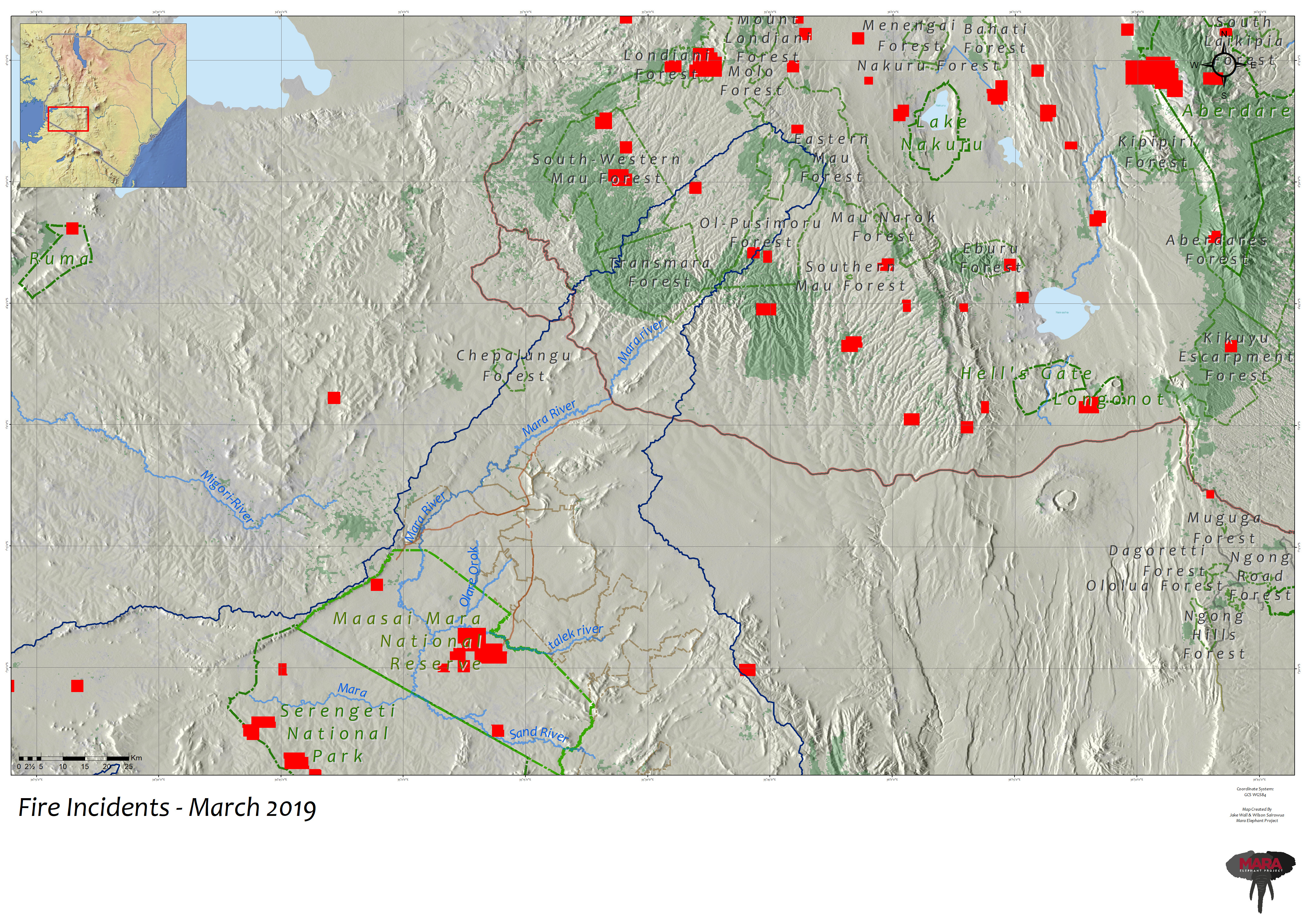 MEP’s research goal for 2019 is to significantly invest time and resources in developing its applied research agenda aimed at enhancing the protection of elephants and the habitat upon which they and other wildlife depend. It’s with this in mind we have several 2019 fundraising objectives for the research and conservation team. The first is to start a long-term monitoring & research team. The data collected from MEP’s elephant collars is the single best indicator for identifying elephant density hotspots, defining critical habitat and corridors, and illustrating elephant movements to target audiences. The ongoing collection of data and further analysis must continue to provide the evidence underpinning the communications and advocacy efforts of the organization to protect this critical habitat into the future. Not only for elephants, but all wildlife that are represented by this umbrella species. To support MEP’s core elephant monitoring and data collection initiative is $172,000 a year. This includes salaries, research permits, download, license and storage fees, telecommunications, travel, publications, research vehicle running costs and research and data analytics. Equipment costing $84,000 is also required to support the new team in collecting and analyzing key data sets, including a dedicated research vehicle, laptop and weather stations. MEP will continue to monitor the movements of elephants using high-resolution GPS tracking. GPS tracking provides a fine-grained view of how elephants partition their time across the landscape and to their movement ecology. MEP will start to monitor each collared elephant in the field more closely to record its life history which helps inform tracking data analyses and provide biological insight.
MEP’s research goal for 2019 is to significantly invest time and resources in developing its applied research agenda aimed at enhancing the protection of elephants and the habitat upon which they and other wildlife depend. It’s with this in mind we have several 2019 fundraising objectives for the research and conservation team. The first is to start a long-term monitoring & research team. The data collected from MEP’s elephant collars is the single best indicator for identifying elephant density hotspots, defining critical habitat and corridors, and illustrating elephant movements to target audiences. The ongoing collection of data and further analysis must continue to provide the evidence underpinning the communications and advocacy efforts of the organization to protect this critical habitat into the future. Not only for elephants, but all wildlife that are represented by this umbrella species. To support MEP’s core elephant monitoring and data collection initiative is $172,000 a year. This includes salaries, research permits, download, license and storage fees, telecommunications, travel, publications, research vehicle running costs and research and data analytics. Equipment costing $84,000 is also required to support the new team in collecting and analyzing key data sets, including a dedicated research vehicle, laptop and weather stations. MEP will continue to monitor the movements of elephants using high-resolution GPS tracking. GPS tracking provides a fine-grained view of how elephants partition their time across the landscape and to their movement ecology. MEP will start to monitor each collared elephant in the field more closely to record its life history which helps inform tracking data analyses and provide biological insight.
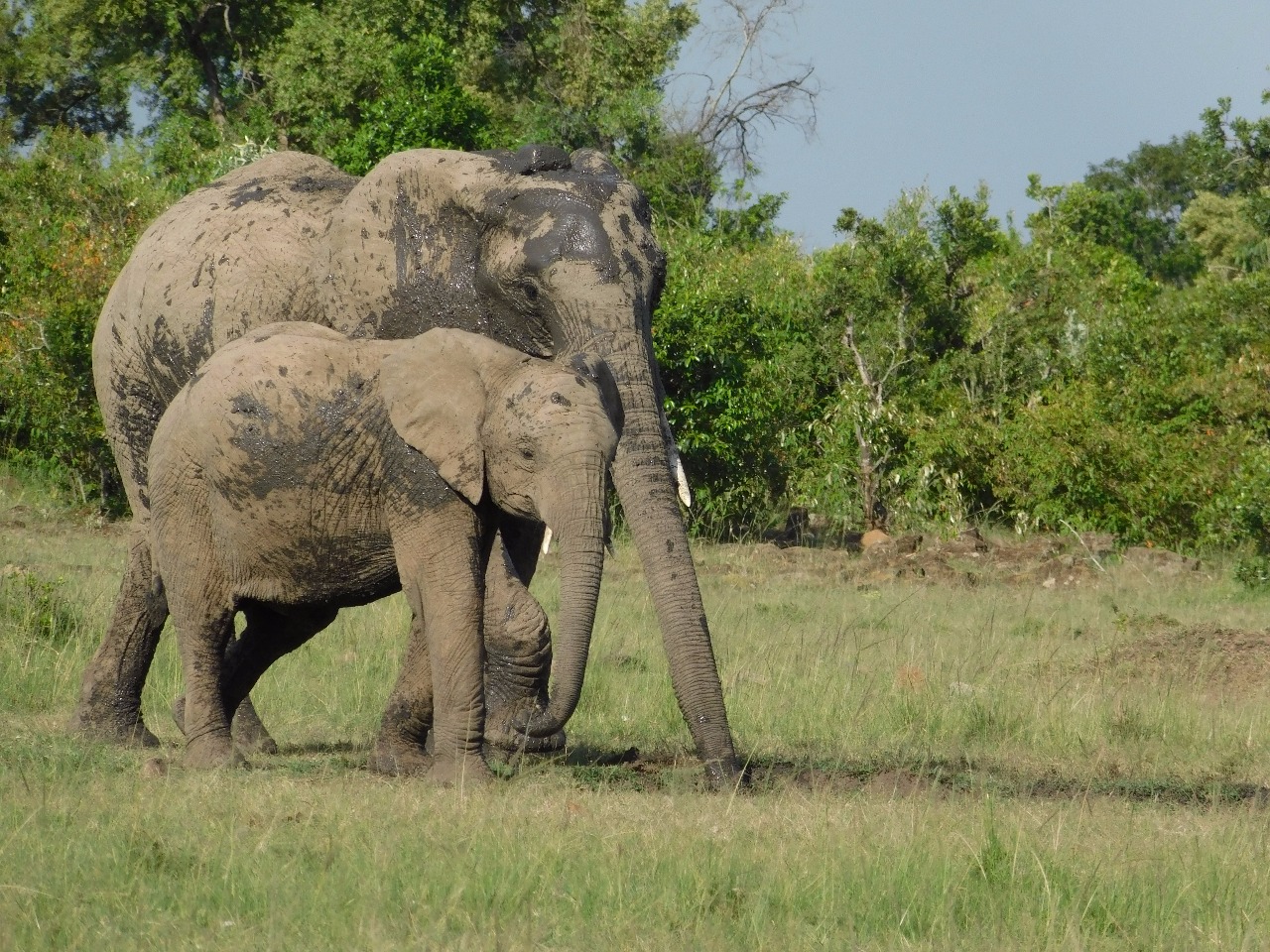
MEP collared elephant Ivy photographed from the field in the first quarter of 2019.
In 2019, MEP would like to increase the amount of demographic data it is collecting on the Mara elephant population. We would like to continue with the work started by Dr. Joyce Poole and extend the Elephant Voices individual ID database by establishing a long-term elephant monitoring program. Individual ID studies can provide critical insight into population structure (e.g., total population numbers, sex ratios and age structure), social behavior, and act as an early warning system for increased levels of poaching or HWC. The employment of two Maasai women would be critical to ensuring the monitoring and data collection continues to grow for MEP in 2019 in the Mara. This long-term monitoring team would report directly to Jake and would initially focus on the continued monitoring of MEP’s collared elephants and the identification of other elephants in the greater population. The long-term monitoring team would need a vehicle to traverse MEP’s area of operation ($25,000), vehicle running costs ($18,000), two cameras with a long-lenses for high resolution photos ($3,000), rations ($1,500), a set of binoculars ($1,000), mobile phones for data collection ($3,000), uniforms ($1,200), and a tracking device for their vehicle ($500) in addition to the salaries of the two staff members ($24,000) for a total of $77,200 for 2019. If you are interested in learning more about how you can support MEP’s long-term monitoring team, please email us.

MEP rangers in the field taking notes and monitoring a herd of elephants.
Finally, one of the key visuals that MEP’s research team can use when speaking to operational partners, government, conservation organizations and supporters is maps. We have many key maps that the research team develops using Geographic Information System (GIS) software. A map is a very clear visual of the data we’re collecting in the Mara on elephant movements, vegetation, settlements, fences, roads and more. The maps are used online and in papers but to have a large print out that everyone can gather around to see where MEP’s collared elephants move in the ecosystem really makes an impact. The MEP office is a safe environment for MEP to now have a map printer installed and having our own printer is more cost effective than paying for them to be printed in Nairobi where we pay $60 a map. We’d need to use the MEP map printeronly 65 times to break even on the cost of the printer and supplies of $4,000.
DONATE
